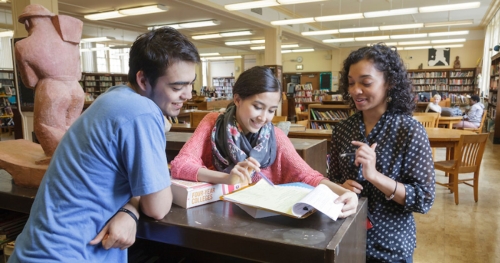The College Match Program

Overview
To remain globally competitive and to advance economic opportunity for all its residents, the United States must dramatically increase the number of low-income students who enroll in and graduate from college. Despite the broad political consensus on this point — and a significant investment of resources by public and private funders — efforts to restructure high schools and reshape curricula have so far produced only modest improvements in college-going rates.
While large-scale education reform initiatives may succeed in the long term, a more targeted and cost-effective strategy offers potential for real impact in the near term. This approach focuses on academically capable, low-income and minority students who do graduate from high school and are well prepared for college. These are students who should enroll in college and should graduate — but very few do. Instead, thousands of these students choose to attend nonselective four-year colleges, where graduation rates are distressingly low. Others enroll at two-year colleges, where degree completion and transfer rates are even lower. Many more do not attend college at all.
This phenomenon — dubbed “undermatching” — was first examined by Melissa Roderick and her colleagues at the Consortium on Chicago School Research at the University of Chicago. “Undermatching” was also described in the highly acclaimed Crossing the Finish Line by William Bowen, Matthew Chingos, and Michael McPherson. Perhaps counterintuitively, the authors of Crossing the Finish Line found compelling evidence that students are most likely to succeed and graduate when they attend the most academically demanding institution that will admit them. For that reason, students who enroll in colleges for which they are overqualified are placing their own academic futures at risk.
Additional Project Details
Agenda, Scope, and Goals
The College Match Program (CMP) was designed to respond to the undermatching problem by encouraging academically capable students to choose colleges where they are likely to thrive and graduate. CMP actively delivers crucial information, supports students as they navigate the complicated college and financial aid application process, and helps students and parents make thoughtful decisions about college enrollment.
CMP targets students who are prepared for college but need advice and support to choose the right college. Importantly, CMP is not focused on getting students into the most elite colleges and universities; rather, CMP seeks to increase the rate at which students apply to, are admitted to, and enroll in “match” colleges that fit their academic profiles and meet their financial and personal needs. In many cases, CMP works with students who expected to enroll in two-year community colleges — or who did not plan to attend college at all. CMP advisers help those students understand that a selective four-year college is a practical, affordable, and superior option.
Beginning in the spring semester of a student’s junior year and extending through high school graduation, College Match delivers services through a combination of workshops and counseling by specially trained College Match advisers. These advisers replicate what is available to help students in more affluent schools and homes make informed decisions about college enrollment.
While CMP targets a relatively small percentage of high school students, those students represent an overlooked segment of the large population that is struggling to reach and complete college. MDRC hopes that the lessons learned in helping these low-income and first-generation students choose colleges that best meet their needs will support efforts to help a much larger student population make informed college choices in the future. Moreover, CMP’s highly personalized approach may ultimately prove more cost-effective than passive, technology-driven college advising strategies. At a minimum, MDRC believes there is value in rigorously testing and comparing a variety of approaches to combat the undermatching problem.
Design, Sites, and Data Sources
The Model
The pilot intervention, delivered through a combination of classroom activities and one-on-one meetings, is staffed by “near peer” or young adult advisers who are recent college graduates. Since the program’s inception, several of the College Match advisers have been alumni of the College Advising Corps (CAC), an innovative program whose mission is to increase the number of low-income, first-generation college and underrepresented high school students who enter and complete higher education.
The College Match Program is organized around several key elements:
- Sharing information and building awareness: CMP provides knowledge to students and their families about general application strategies, financial aid, and the concept of a “match” college. The program also exposes students to more selective colleges through campus tours and visits from alumni and admissions representatives.
- Individual advising: CMP helps students identify “best-fit” colleges based on their individual interests, academic abilities, and other personal and family considerations.
- Application support: CMP helps students navigate the complex college application process, advising them on how to develop competitive applications and essays, procure fee waivers, and complete the Free Application for Federal Student Aid (FAFSA).
- Parental engagement: CMP helps parents understand the college options available to their children and the financial and personal implications of those choices.
- Making decisions and planning ahead: If students receive multiple acceptances and financial aid awards, CMP helps them choose among them. Advisers also help students to prepare for college life and transition to college enrollment.
Chicago
For three years, starting in fall 2010, the Chicago Public Schools hosted CMP. More than 1,000 students in eight high schools were served. Eligible students had a grade point average of 3.0 and a 20 on the ACT exam.
New York City
Building off the Chicago work, in fall 2013 CMP expanded to New York City, where a one-year pilot program operated. Approximately 150 students were served in two high schools. Eligible students typically had a grade point average of 3.0 and an SAT score consistent with the City University of New York’s college-readiness standards.







